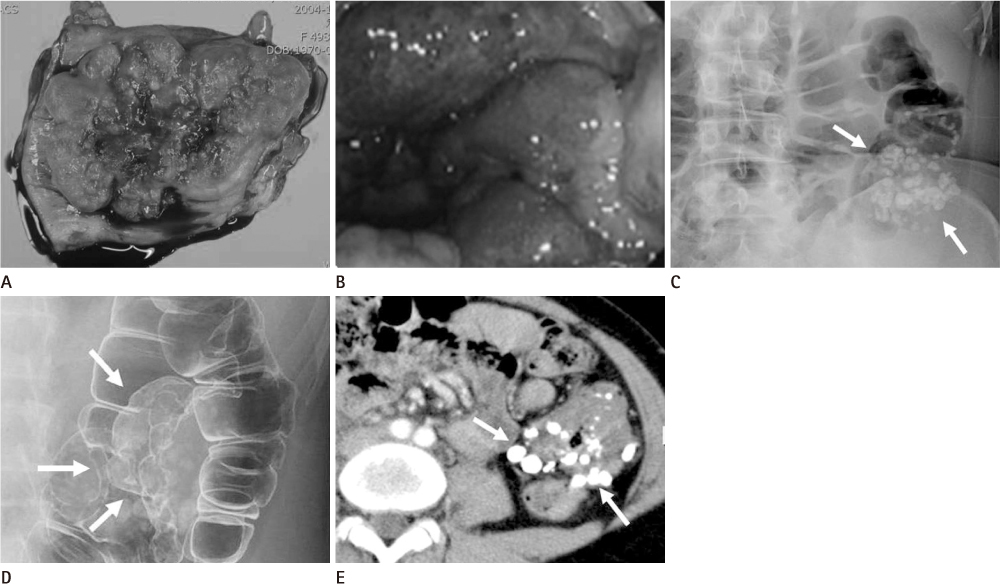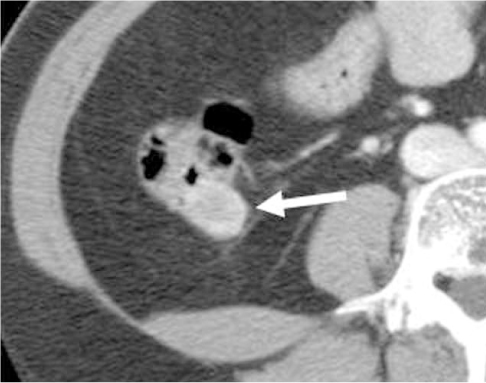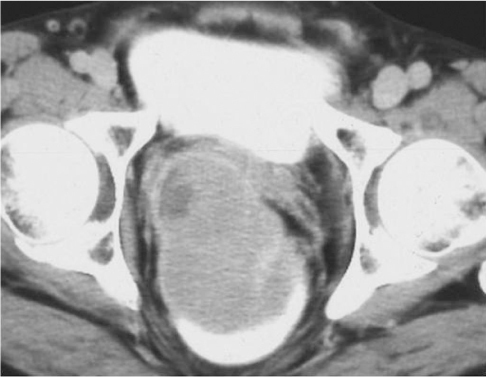J Korean Soc Radiol.
2011 Sep;65(3):275-284.
Unusual Primary Subepithelial Tumors of the Colon: Multimodality Imaging Findings with Endoscopic and Pathologic Correlation
- Affiliations
-
- 1Department of Diagnostic Radiology, Dong-A University College of Medicine, Busan, Korea. medcarrot@naver.com
- 2Department of Internal Medicine, Dong-A University College of Medicine, Busan, Korea.
- 3Department of Diagnostic Radiology, Pusan National University College of Medicine, Busan, Korea.
Abstract
- The colonoscopy has been used to diagnose various colonic lesions. However, this method has its limitations in diagnosing and differentiating subepithelial tumors. For this reason, the role of cross-sectional radiologic imaging is important for the diagnosis of colonic subepithelial tumors. Moreover, although these tumors are associated with a wide range of radiologic features, they may have unique radiologic features that suggest a specific diagnosis. Hemangiomas typically show transmural colonic wall thickening with phleboliths in intramural or extracolic areas. Colonic lymphangiomas manifest as a multilocular cystic mass at CT and sonography. Colonic lipomas are well demonstrated by CT because the masses were present with characteristic fatty density. Schwannomas usually appear as well circumscribed, homogeneous masses with low attenuation at CT. The primary form of colonic lymphoma has a wide variety of radiologic types, including a polypoid mass, circumferential mural mass, and a cavitary mass. Small gastrointestinal stromal tumors are usually homogeneous, whereas larger tumors tend to have a heterogeneous appearance with central necrosis at contrast-enhanced CT scans. Neuroendocrine tumors of the colon are most frequently observed in the rectum and are typically small incidental lesions. Familiarity with these imaging features can help distinguish particular disease entities.
MeSH Terms
Figure
Reference
-
1. Pickhardt PJ, Kim DH, Menias CO, Gopal DV, Arluk GM, Heise CP. Evaluation of submucosal lesions of the large intestine: part 1. Neoplasms. Radiographics. 2007; 27:1681–1692.2. Hsu RM, Horton KM, Fishman EK. Diffuse cavernous hemangiomatosis of the colon: findings on three-dimensional CT colonography. AJR Am J Roentgenol. 2002; 179:1042–1044.3. Wan YL, Lee TY, Hung CF, Ng KK. Ultrasound and CT findings of a cecal lymphangioma presenting with intussusception. Eur J Radiol. 1998; 27:77–79.4. Genchellac H, Demir MK, Ozdemir H, Unlu E, Temizoz O. Computed tomographic and magnetic resonance imaging findings of asymptomatic intra-abdominal gastrointestinal system lipomas. J Comput Assist Tomogr. 2008; 32:841–847.5. Levy AD, Quiles AM, Miettinen M, Sobin LH. Gastrointestinal schwannomas: CT features with clinicopathologic correlation. AJR Am J Roentgenol. 2005; 184:797–802.6. Harned RK, Buck JL, Shekitka KM. Inflammatory fibroid polyps of the gastrointestinal tract: radiologic evaluation. Radiology. 1992; 182:863–866.7. Ghai S, Pattison J, Ghai S, O'Malley ME, Khalili K, Stephens M. Primary gastrointestinal lymphoma: spectrum of imaging findings with pathologic correlation. Radiographics. 2007; 27:1371–1388.8. Levy AD, Remotti HE, Thompson WM, Sobin LH, Miettinen M. radiologic features with pathologic correlation. Radiographics. 2003; 23:283–304. 456quiz 532.9. Levy AD, Remotti HE, Thompson WM, Sobin LH, Miettinen M. Anorectal gastrointestinal stromal tumors: CT and MR imaging features with clinical and pathologic correlation. AJR Am J Roentgenol. 2003; 180:1607–1612.10. Levy AD, Sobin LH. From the archives of the AFIP: Gastrointestinal carcinoids: imaging features with clinicopathologic comparison. Radiographics. 2007; 27:237–257.
- Full Text Links
- Actions
-
Cited
- CITED
-
- Close
- Share
- Similar articles
-
- Endoscopic Full-Thickness Resection for Gastric Subepithelial Lesions Arising from the Muscularis Propria
- Unusual Metachronous Renal Pelvis and Colon Metastases in a Patient with Endometrial Cancer: A Case Report
- Contrast Enhanced Endoscopic Ultrasound Imaging for Gastrointestinal Subepithelial Tumors
- Endoscopic Treatment of Subepithelial Tumors
- Endoscopic Management of Gastric Subepithelial Tumor










